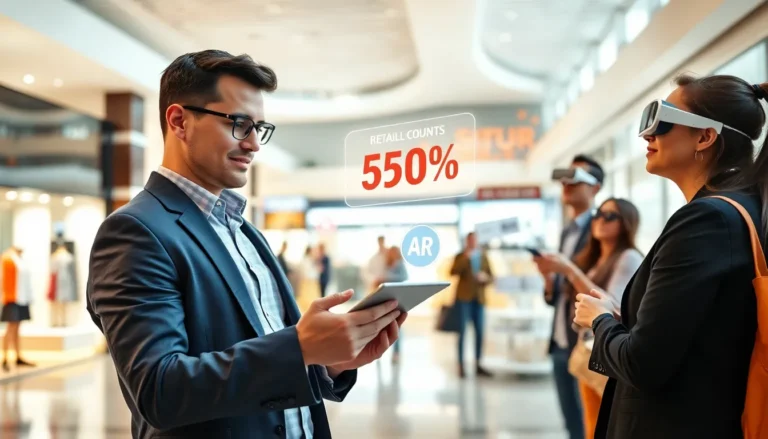In a world where tech is racing ahead, augmented reality (AR) isn’t just for flashy games anymore. It’s stepping into the boardroom and transforming how businesses operate. Imagine guiding your team through interactive data visualizations or letting clients experience a product before they buy, all without the awkwardness of a hard sell. If business leaders are still ignoring augmented reality, they’re likely missing out on a goldmine of opportunities. AR consulting can be the key to not just keeping up but leading the charge into the future. So, grab a comfy seat, and let’s explore how augmented reality consulting reshapes the business landscape.
Table of Contents
ToggleUnderstanding Augmented Reality

Augmented reality, or AR, overlays digital information onto the real world. Unlike virtual reality, which immerses users entirely in a digitally created environment, AR enhances our existing environment by adding layers of information or graphical elements. Imagine walking through a furniture store and using your phone to see how that stylish sofa looks in your living room. This technology works via smartphones, tablets, and specialized AR glasses, merging the physical with the digital. As AR technology evolves, its applications expand, making the business case for augmented reality consulting much stronger.
Applications of Augmented Reality in Various Industries
Augmented reality isn’t a one-trick pony: its applications span across multiple industries.
- Retail: Shoppers can visualize products in their homes before making purchases, significantly lowering return rates. Retail giants like IKEA have already started leveraging AR to enhance the shopping experience.
- Healthcare: Surgeons can use AR to project critical information during operations or train on anatomical models without risking patient safety.
- Real Estate: Virtual property tours allow potential buyers to see homes from the comfort of their couches, making the buying process less daunting.
- Manufacturing: AR aids technicians by overlaying schematics on machinery, reducing errors and training time.
- Education: Interactive content makes learning experiences more engaging, helping students understand complex subjects through practical applications.
These sectors, among others, showcase AR’s versatility and its potential to revolutionize everyday operations.
Benefits of Augmented Reality Consulting Services
The benefits of augmented reality consulting services are manifold. Here are some key advantages:
- Enhanced Customer Engagement: By presenting information in an enjoyable and immersive way, companies can boost customer interest and loyalty. Consider how an AR app could demonstrate a product’s features in real-time, creating a memorable experience.
- Increased Efficiency: AR can simplify processes, allowing employees to access crucial data hands-free, which minimizes downtime and errors.
- Cost-Effectiveness: While implementing AR technology may seem like a hefty investment, the long-term savings achieved through improved efficiency and reduced training costs can outweigh initial expenses.
- Innovation and Competitiveness: Companies utilizing AR consulting can tap into innovative solutions that set them apart from competitors. It positions businesses as forward-thinking leaders in their respective industries.
Choosing the Right Augmented Reality Consulting Partner
Selecting the right AR consulting partner is no walk in the park. Businesses should consider several factors:
- Experience and Portfolio: Look for partners with a proven track record in the field. Check their previous projects to gauge their expertise and creativity.
- Technology and Tools: Ensure that the consulting firm uses state-of-the-art technologies and possesses the right tools for effective AR experiences.
- Understanding Your Business Needs: A great consulting partner should tailor their solutions according to the specific needs of your business. This personalized approach often leads to successful implementation.
- Post-Implementation Support: The best firms will not only assist in rolling out AR solutions but also provide ongoing support and updates.
Implementing Augmented Reality Solutions
Implementing AR solutions involves a series of steps:
- Conducting a Needs Assessment: Understanding what you want to achieve is crucial. Define the objectives and identify areas where AR can enhance your operations.
- Developing the AR Strategy: Once objectives are established, collaborate with your consulting partner to outline a detailed AR strategy that includes project timelines, budget considerations, and key milestones.
- Creating Content: AR thrives on visuals. Invest in high-quality graphics or experiences that clearly communicate the message.
- Testing: Before the official launch, testing AR applications is vital to ensure functionality and user experience are optimal. Feedback during this stage can lead to important adjustments.
- Training Staff: Employees must be trained on how to use AR technology effectively. Providing the right resources will guarantee that staff can use AR solutions to their full potential.
Future Trends in Augmented Reality Consulting
The future of augmented reality consulting looks bright, with several emerging trends expected to shape the landscape:
- Widespread Adoption of AR Glasses: The advancement of lightweight AR glasses could revolutionize how industries operate, enhancing user experience while keeping hands free for tasks.
- Integration with AI: Combining AR with artificial intelligence will lead to more personalized user experiences, making interactions smarter and more intuitive.
- 5G Technology: Faster connectivity with 5G will improve the quality of AR applications, allowing rich, real-time experiences without lag.
- Sustainability Initiatives: AR can potentially help businesses reduce waste and travel needs through virtual training and simulations, aligning with growing environmental concerns.
These trends indicate that businesses will increasingly rely on AR consulting to stay relevant and competitive.









